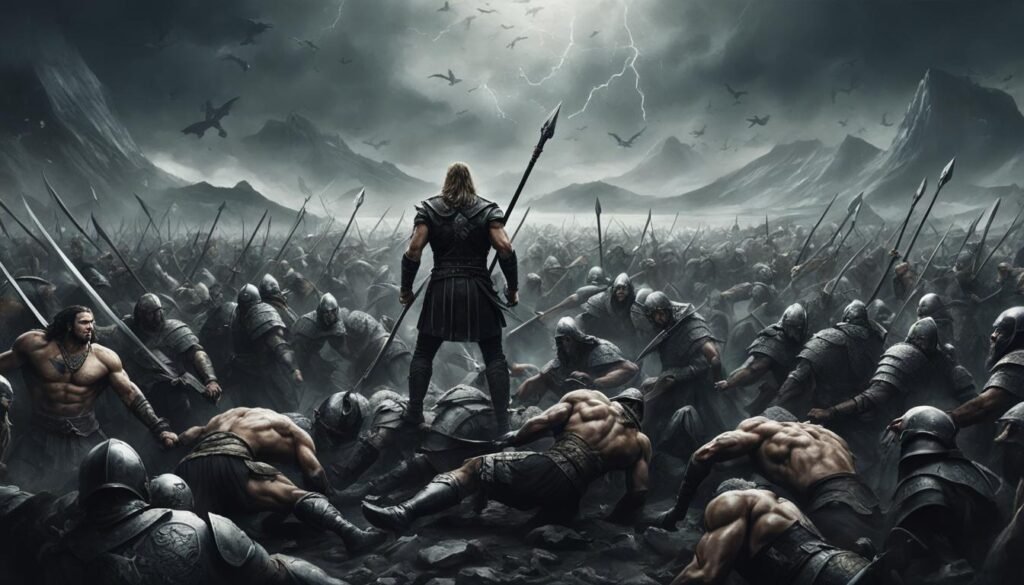In Norse mythology, Tyr, the god of war and justice, meets a tragic end during the events of Ragnarök, the final battle of the gods. His demise is intertwined with his encounter with the monstrous hellhound Garmr, where he demonstrates his bravery and sacrifice for the salvation of the gods.
Key Takeaways:
- Tyr, the Norse god of war and justice, sacrifices his hand to bind the monstrous wolf Fenrir, ultimately leading to his demise during Ragnarök.
- He is often associated with the ancient Roman war god Mars and is honored with the day of the week known as Tuesday.
- Tyr’s role extends beyond warfare, as he is also regarded as a god of justice and law.
- Before the Germanic peoples had their distinct religious traditions, they worshipped *Dyeus, a Proto-Indo-European sky god who evolved into the Germanic god Tyr.
- Tyr’s sacrifice in the Binding of Fenrir exemplifies his commitment to upholding justice and showcases the importance of law in resolving conflicts among the gods.
Tyr: A God of War and Justice
Tyr, a prominent figure in Norse mythology, is not only renowned as a god of war but also as a deity associated with justice and law. While he stands among the principal war gods alongside Odin and Thor, his role transcends mere combat. In ancient Germanic religion, war and law were deeply intertwined, and Tyr exemplifies this connection through his association with justice.
One of the most significant myths featuring Tyr is the Binding of Fenrir, where he sacrifices his hand to bind the monstrous wolf. In this act, Tyr upholds the principles of justice, as he offers his own body as collateral to ensure the lawful resolution of conflicts. This sacrifice epitomizes Tyr’s unwavering commitment to maintaining order and ensuring fair outcomes.
As a divine jurist, Tyr embodies the importance of law in Germanic society. In the Binding of Fenrir myth, his sacrifice symbolizes the necessary sacrifices and difficult choices that must be made to preserve harmony and balance within the Norse pantheon. His selflessness and dedication to justice distinguish him as a god of noble character and unwavering integrity.
The role of Tyr as a god of justice and law highlights the intricacies of early Germanic religion and its fusion of war and legal principles. In the ancient Germanic worldview, the establishment and preservation of order were fundamental aspects of a flourishing society. Tyr, with his emphasis on just resolutions and adherence to established laws, embodied these ideals.
Through Tyr’s sacrifice and his embodiment of justice, he stands as a pillar of virtue and an important figure in Norse mythology. With his intricate connection to war, justice, and law, Tyr’s significance in Germanic religion is a testament to the multifaceted nature of the gods and the complex beliefs of the ancient Norse people.
Tyr’s Predecessor: *Dyeus and his Proto-Indo-European Roots

The Sky Father and the Evolution of Tyr
Before the development of distinct Germanic religious traditions, the Proto-Indo-European people worshipped *Dyeus, a deity associated with the daytime sky and known as the Sky Father. Over time, *Dyeus evolved into the Germanic god Tyr, who played a significant role in their religious beliefs.
Ancestral Connections: *Dyeus and Tyr
The linguistic similarities between *Dyeus and Tyr hint at their connection. While explicit evidence of Tyr’s association with the sky in Germanic sources is scarce, the T-rune used to represent his name resembles an upward-pointing arrow. This symbol could potentially represent his previous role as a sky god.
Germanic Worship of *Dyeus and Tyr
As Germanic religious traditions developed, the worship of *Dyeus transformed into the veneration of Tyr among the Germanic peoples. While the specifics of *Dyeus’ worship are less known, the reverence for Tyr as a god associated with war, justice, and law became prominent in Germanic cultures.
Visualizing Tyr’s Sky Connection
Although the image is for visual appeal and does not directly represent Tyr’s predecessor *Dyeus, it symbolizes Tyr’s potential connection to the sky and reinforces the discussion of his Proto-Indo-European roots.
- *Dyeus was a Proto-Indo-European deity associated with the sky and known as the Sky Father.
- Germanic worship of *Dyeus evolved into the veneration of Tyr.
- The linguistic similarities between *Dyeus and Tyr suggest a connection to the sky.
- The T-rune used to represent Tyr’s name resembles an upward-pointing arrow, potentially symbolizing his previous role as a sky god.
Tyr’s Role in Ragnarök
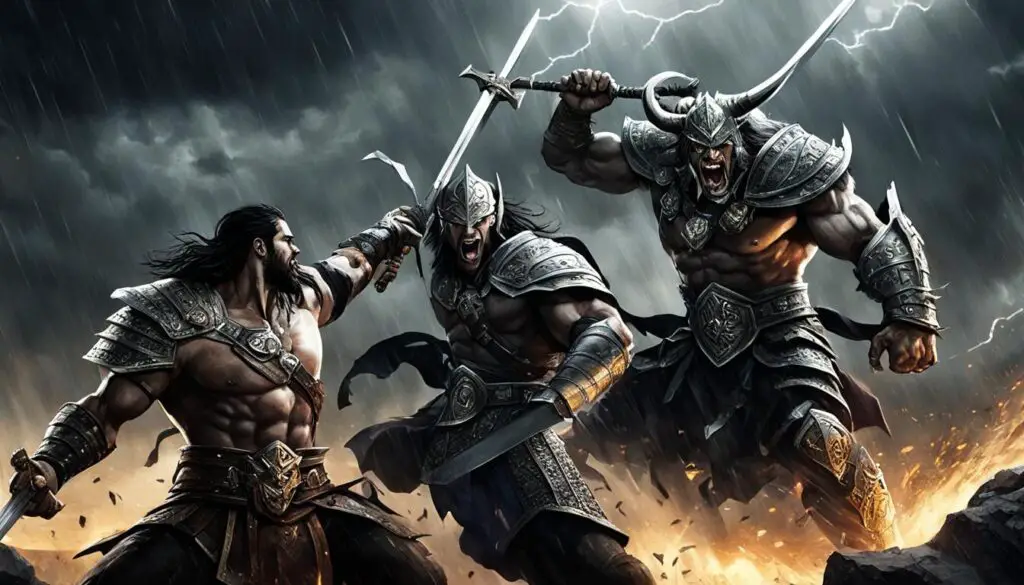
In the epic battle known as Ragnarök, Tyr, the Norse god of war and justice, plays a significant role in the final conflict of the gods. According to Norse mythology, Tyr confronts Garmr, the fearsome hellhound tasked with guarding the realm of Hel.
The encounter between Tyr and Garmr is a pivotal moment in Tyr’s destiny. As the battle ensues, the bravery and wisdom of Tyr are put to the ultimate test. Whether Garmr and Fenrir, the monstrous wolf, are one entity or separate beings remains a topic of debate among scholars.
Despite his valiant efforts, Tyr ultimately meets his fate in the clash with Garmr, emphasizing his sacrificial role in Norse mythology. The selfless and honorable actions of Tyr throughout his myths highlight his unwavering dedication to the gods and his willingness to make profound sacrifices.
In the tragic outcome of his confrontation with the hellhound, Tyr’s legacy as a hero and embodying warrior endures, resonating with the enduring significance of his character in the Norse pantheon.
Tyr’s Family and Origins
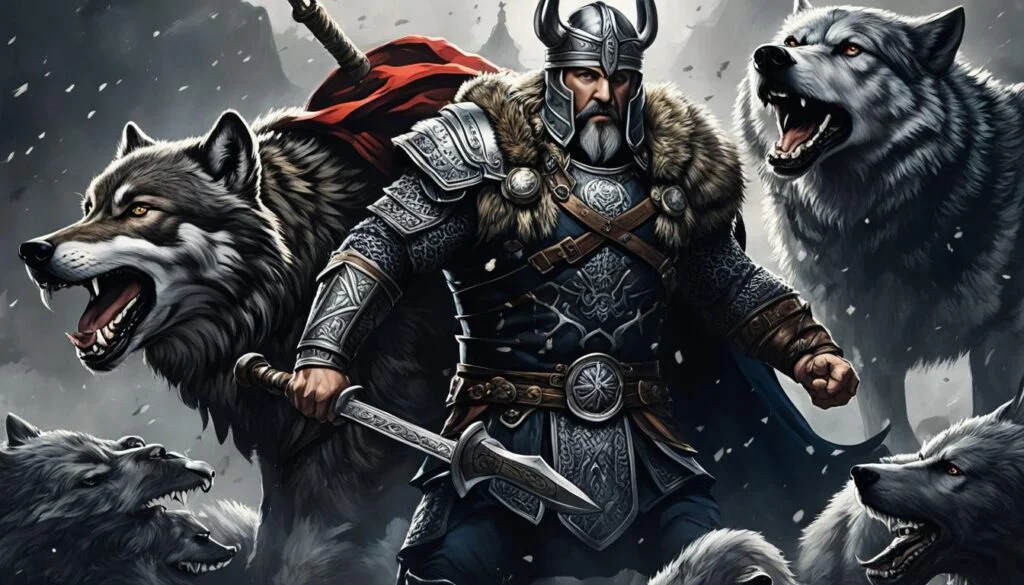
Tyr’s family ties in Norse mythology are somewhat unclear and vary in different sources. According to Snorri Sturluson’s Younger Edda, Tyr is identified as the son of Odin. However, the Edda poem Hymiskviða suggests that he is the son of the giant Hymer. This discrepancy might be due to the evolving nature of Norse myths or different regional variations. Additionally, Tyr’s unnamed consort is mentioned in Lokasenna but remains a mystery with no further details available.
The parentage of Tyr, the Norse god associated with war and justice, is a subject of debate among scholars. According to Snorri Sturluson’s Younger Edda, Tyr is the son of Odin, the Allfather and ruler of the gods. This lineage connects Tyr directly to the highest deity in the Norse pantheon.
However, the Edda poem Hymiskviða presents an alternative account, suggesting that Tyr is the son of the giant Hymer. This conflicting story hints at regional variations or different interpretations of Tyr’s origins within Norse mythology.
Tyr’s possible jötunn heritage adds an intriguing layer to his character. In Norse mythology, jötnar (plural form of jötunn) are often portrayed as giant beings with supernatural abilities. If Tyr is indeed the son of the giant Hymer, it would imply a mixed lineage, blurring the boundaries between the divine and the monstrous.
Furthermore, Tyr’s mysterious consort mentioned in the Lokasenna remains an enigma. While the poem offers no additional information about this elusive figure, it sparks curiosity and speculation about the nature of Tyr’s relationships and potential connections to other deities or beings.
Continuing our exploration of Tyr’s fate in Norse mythology, the next section will focus on his significance in early Germanic mythology and his connection to the Proto-Indo-European deity *Dyeus.
Tyr’s Importance in Early Germanic Mythology
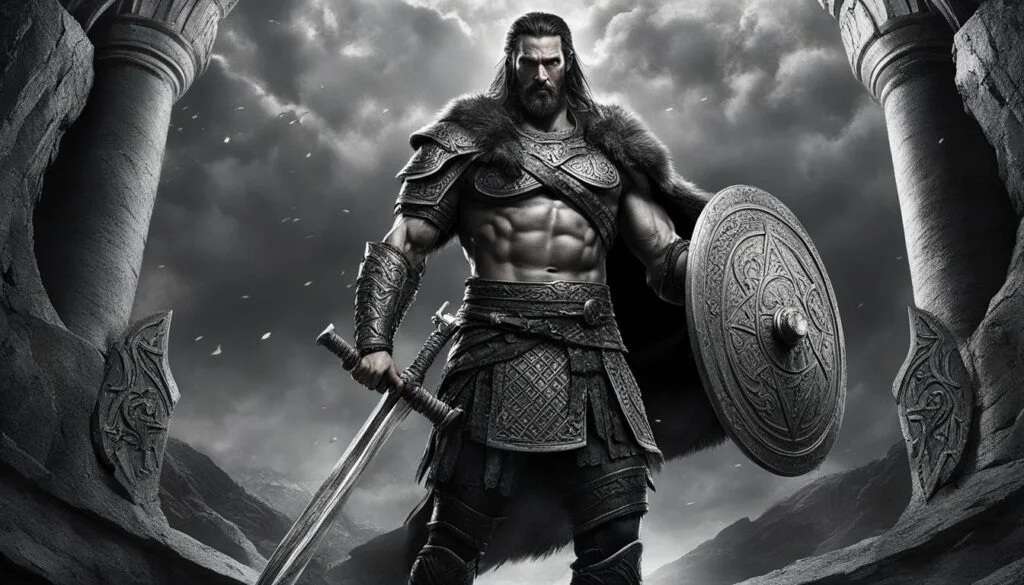
Some scholars speculate that Tyr held a more central place among the deities in early Germanic mythology. The etymology of Tyr’s name and his presence in the extant Germanic corpus support this theory.
Tyr’s name, derived from the Proto-Germanic theonym *Tīwaz, means ‘god’ and is associated with Germanic linguistic roots related to the celestial and heavenly realms. The significance of his name suggests that Tyr occupied a central position among the deities in early Germanic mythology.
While there may be limited direct evidence to comprehensively understand Tyr’s role, linguistic evidence and regional variations provide hints at his importance. The presence of Tyr in various Germanic languages and the association of his name with divinity and celestial realms indicate his influential status among the gods.
- Tyr’s central role: Tyr’s name and linguistic roots suggest a central and prominent position among the deities in early Germanic mythology.
- Tyr’s position among the deities: Despite limited direct evidence, Tyr’s name and presence across Germanic languages indicate his significance and involvement with the divine pantheon.
- Tyr’s etymology and linguistic roots: The Proto-Germanic theonym *Tīwaz, from which Tyr derives, implies his association with the celestial realms and reinforces his important role among the gods.
Tyr’s Associations in Germanic Culture

Tyr’s legendary status extends beyond mythology, permeating various aspects of Germanic culture. The influence of Tyr can be observed in several noteworthy ways:
Tyr in Place Names
Place names in Scandinavia often pay homage to Tyr’s significance. An example of this is Tyrseng in Denmark, which translates to ‘Tyr’s meadow.’ These place names indicate the reverence and importance of Tyr within the cultural landscape.
Tyr’s Depictions in English and Scandinavian Objects
Depictions and representations of Tyr have been discovered on objects found in England and Scandinavia. These art pieces and artifacts illustrate how Tyr was visually portrayed and highlight his significant role in the cultural practices of the Germanic peoples.
Tyr’s Invocation in Germanic Languages
The legacy of Tyr lives on in the Germanic languages. In English and other Germanic languages, Tuesday is recognized as ‘Týr’s day.’ This naming convention serves as a constant reminder of Tyr’s impact and enduring influence in daily life.
Tyr and Fenrir: The Binding of the Monstrous Wolf
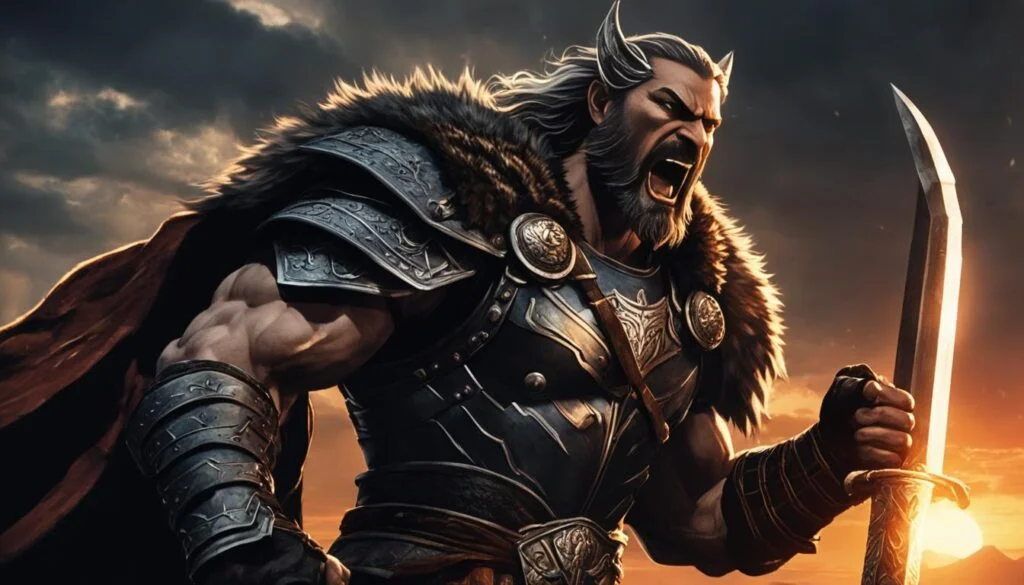
Tyr, the Norse god of war and justice, is prominently known for his heroic act in the Binding of Fenrir. This myth showcases Tyr’s unwavering commitment to justice and his instrumental role in maintaining order within the Norse pantheon.
In the myth, the monstrous wolf Fenrir poses a significant threat to the gods. As a pledge of good faith, Tyr offers his hand to Fenrir, allowing the wolf to bite down and secure the binding. This sacrifice demonstrates Tyr’s bravery and willingness to put the greater good above his personal well-being.
The Binding of Fenrir plays a crucial role in Ragnarök, the final battle of the gods. Fenrir, contained by Tyr’s sacrifice, is a central figure in the cataclysmic event that marks the end of the world. Tyr’s role in binding Fenrir contributes to the delicate balance between chaos and order that characterizes Ragnarök.
Tyr’s sacrifice and instrumental role in the Binding of Fenrir highlight his unwavering dedication to justice and the preservation of the cosmos. This myth emphasizes the significance of sacrifice and the complexities of maintaining order in the face of inevitable destruction.
Tyr’s Role in the Victory of the Gods
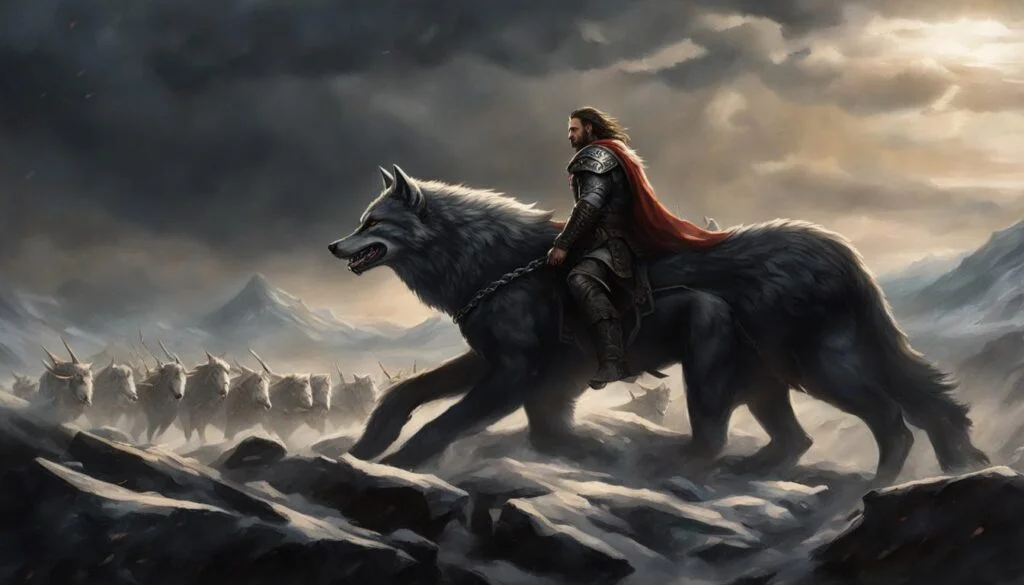
Tyr’s sacrifice in the Binding of Fenrir not only secures the gods’ salvation by containing the monstrous wolf but also establishes the legitimacy and legality of their actions. Georges Dumézil suggests that Tyr’s sacrifice legalizes the gods’ salvation, rendering it valid and just. Similar to Odin’s sacrifice of his eye for wisdom, Tyr’s sacrifice of his hand exemplifies his dedication to upholding law and ensuring the righteous resolution of conflicts among the gods.
In Norse mythology, Tyr’s role in the victory of the gods is pivotal. His selfless act of sacrificing his hand to bind Fenrir, the powerful wolf destined to bring destruction during Ragnarök, demonstrates his commitment to preserving order and protecting the gods and their realm. This sacrifice not only restrains the monstrous wolf but also plays a crucial role in legitimizing the gods’ actions and ensuring their salvation.
The myth of the Binding of Fenrir serves as a powerful symbol of Tyr’s role as a righteous and just deity. By offering his hand as a pledge, Tyr upholds the principles of law and justice, showcasing his unwavering commitment to ensuring the lawful resolution of conflicts among the gods. Just as Odin’s sacrifice of his eye grants him wisdom, Tyr’s sacrifice establishes his position as a figure of divine sacrifice and legal authority.
Tyr’s sacrifice in the Binding of Fenrir represents the gods’ triumph over chaos and embodies the values of courage, selflessness, and the pursuit of justice. It emphasizes the importance of sacrifice in the face of adversity and the role of law in maintaining cosmic order. Tyr’s courageous act not only secures the gods’ victory but also highlights his crucial role in the pantheon and solidifies his legacy as a deity of war, justice, and unwavering devotion.
Tyr and his Associations with Law and Justice
Tyr’s reputation as a god of law and justice extends beyond his legendary feats, such as the Binding of Fenrir. He is closely connected to the ancient Germanic legal assembly, known as the Þing, where disputes were resolved and laws were upheld.
As a divine jurist, Tyr symbolizes the principles of fairness, order, and righteousness. His sacrifice in the Binding of Fenrir exemplifies his unwavering commitment to upholding justice, even at great personal cost. By willingly sacrificing his hand, Tyr showcases the importance of law in resolving conflicts and maintaining harmony.
The Germanic legal assembly, the Þing, regarded Tyr as an embodiment of legal principles. His role as a divine jurist highlights his significance in ensuring the proper functioning of the legal system and maintaining social order.
Through his association with law and justice, Tyr serves as a moral compass and a beacon of righteousness within the Norse pantheon. His unwavering commitment to upholding justice makes him a revered and respected figure among the gods.
The Germanic Legal Assembly: The Þing
The Þing was an integral part of Germanic society and served as the primary forum for legal proceedings and dispute resolution. It was a gathering of free men who came together to discuss and decide matters of law and order.
Tyr’s association with the Þing underscores his role as a god of law and his importance in upholding justice. As the divine jurist, Tyr provided guidance and wisdom to those seeking legal resolutions, ensuring fair and equitable outcomes.
- Tyr’s representation of legal principles in the Þing.
- Tyr’s role in guiding the decisions and resolutions of legal disputes.
- The reverence and respect accorded to Tyr within the Germanic legal system.
Tyr’s Legacy and Cultural Influence
Despite the fading prominence of Tyr in surviving Norse myths during the later Viking Age, his legacy and cultural influence are still evident today. Known for his association with courage, justice, and honorable warfare, Tyr’s impact on Nordic culture remains significant.
In Viking Age worship, Tyr held a special place of veneration, particularly in Denmark. This is evident from the abundance of place names and historical records associated with his worship in the region.
Although the extent of Tyr’s importance and worship may have varied across different regions and time periods, his influence on Norse and Germanic culture cannot be overlooked. His depiction as a brave and just deity resonated with the values held by the Nordic peoples.
Tyr’s enduring legacy can be seen in the historical accounts, artwork, and cultural practices that have been passed down through generations. His role as a god of war, law, and justice continues to inspire and captivate those with an interest in ancient Norse mythology.
Conclusion
Tyr, the Norse god of war, justice, and law, meets a tragic demise in his encounter with the hellhound Garmr during Ragnarök. His sacrifice and heroic acts, especially in the Binding of Fenrir, exemplify his role in maintaining order and ensuring justice in the Norse pantheon. Tyr’s legacy as a god and his cultural influence are seen in his associations with war and law, as well as his impact on Germanic and Nordic cultures. Although Tyr’s prominence may have waned over time, his importance in Norse mythology and his symbolic significance endure.
FAQ
How does Tyr die in Norse Mythology?
Tyr meets his demise during the events of Ragnarök when he confronts the hellhound Garmr.
What is Tyr’s role in Norse mythology?
Tyr is known as a valorous and powerful god, patronizing warriors and mythological heroes. He is also regarded as a god of justice and law.
Who is Tyr associated with in Roman mythology?
Tyr’s name is associated with the ancient Roman war god Mars.
What is the significance of Tyr sacrificing his hand?
Tyr sacrifices his hand to bind the monstrous wolf Fenrir, showcasing his commitment to maintaining order and ensuring the lawful resolution of conflicts.
What is Tyr’s connection to the Proto-Indo-European deity *Dyeus?
Tyr is believed to have evolved from the Proto-Indo-European deity *Dyeus, who was associated with the daytime sky.
What happens to Tyr during Ragnarök?
Tyr’s fate is intertwined with the last battle of the gods, where he confronts the hellhound Garmr and ultimately faces his demise.
Who are Tyr’s parents in Norse mythology?
According to different sources, Tyr is identified as the son of Odin or the giant Hymer, which leads to some ambiguity regarding his family ties.
What is Tyr’s significance in early Germanic mythology?
Tyr’s name and linguistic roots suggest a more central role among the Germanic deities, although direct evidence is limited.
How is Tyr venerated in Germanic culture?
Tyr’s influence is seen in place names and depictions in objects found in England and Scandinavia. Additionally, the day Tuesday is named after Tyr.
What is Tyr’s most famous myth?
Tyr’s most prominent myth is the Binding of Fenrir, in which he sacrifices his hand to secure the confinement of the monstrous wolf.
What is Tyr’s association with law and justice?
Tyr is closely linked to the ancient Germanic legal assembly, known as the Þing, and is considered a representation of legal principles in Norse mythology.
What is Tyr’s legacy and cultural influence?
Tyr’s association with courage, justice, and honorable warfare left a lasting impact on Nordic culture, as evidenced by his worship and place names.
What can we conclude about Tyr’s fate in Norse mythology?
Tyr’s demise in Ragnarök and his sacrificial acts in the Binding of Fenrir exemplify his role in maintaining order and ensuring justice in the Norse pantheon.


